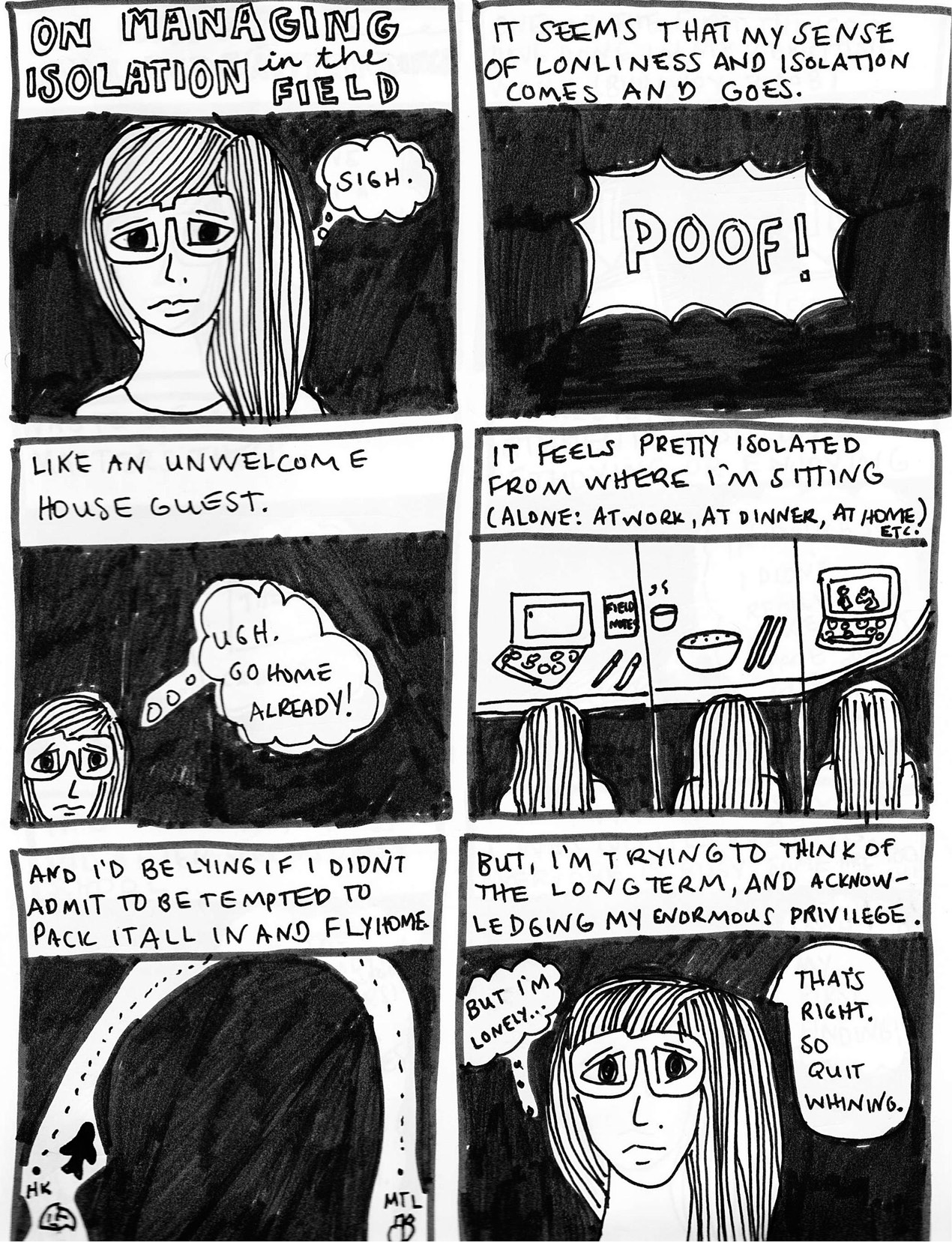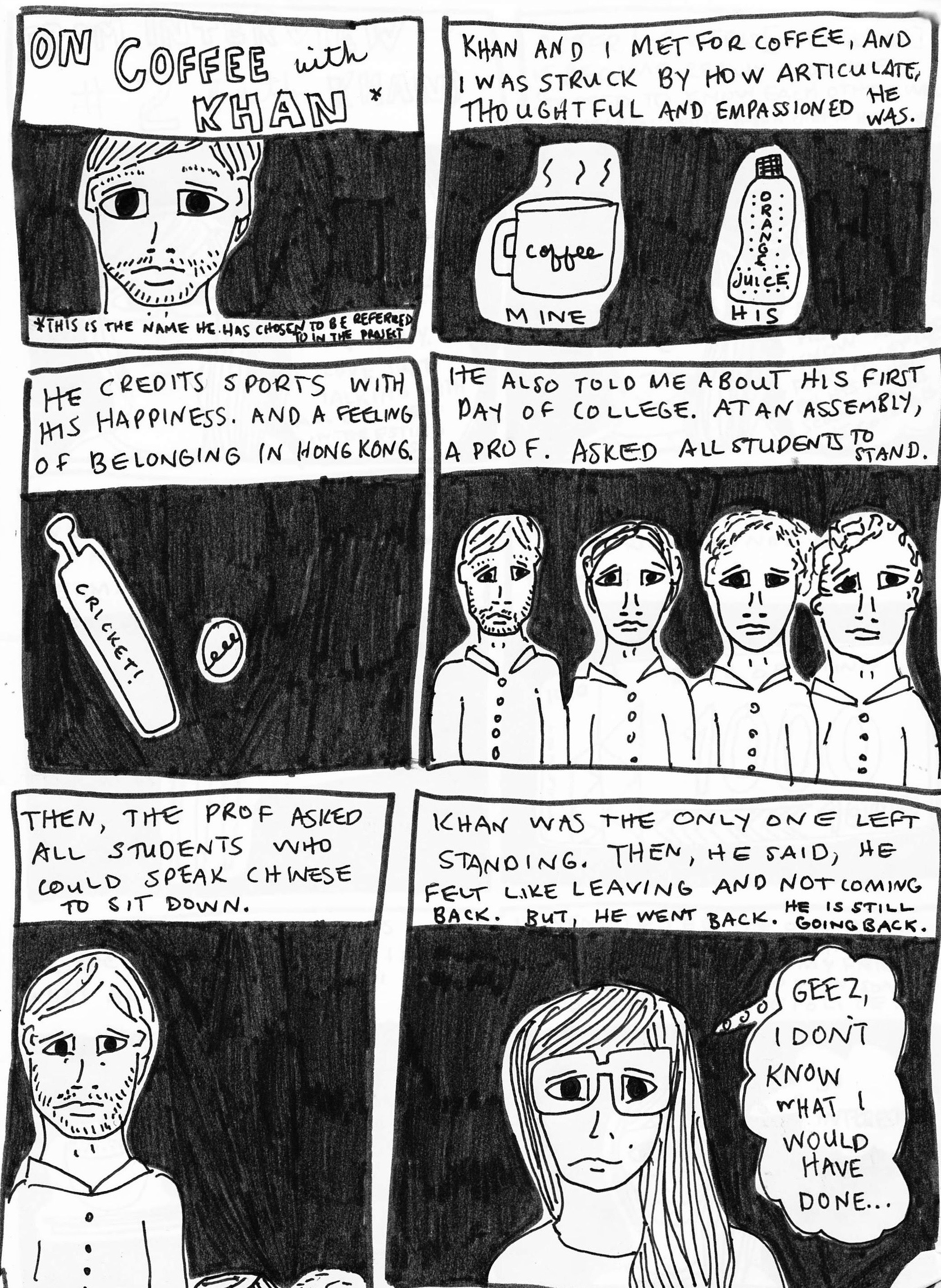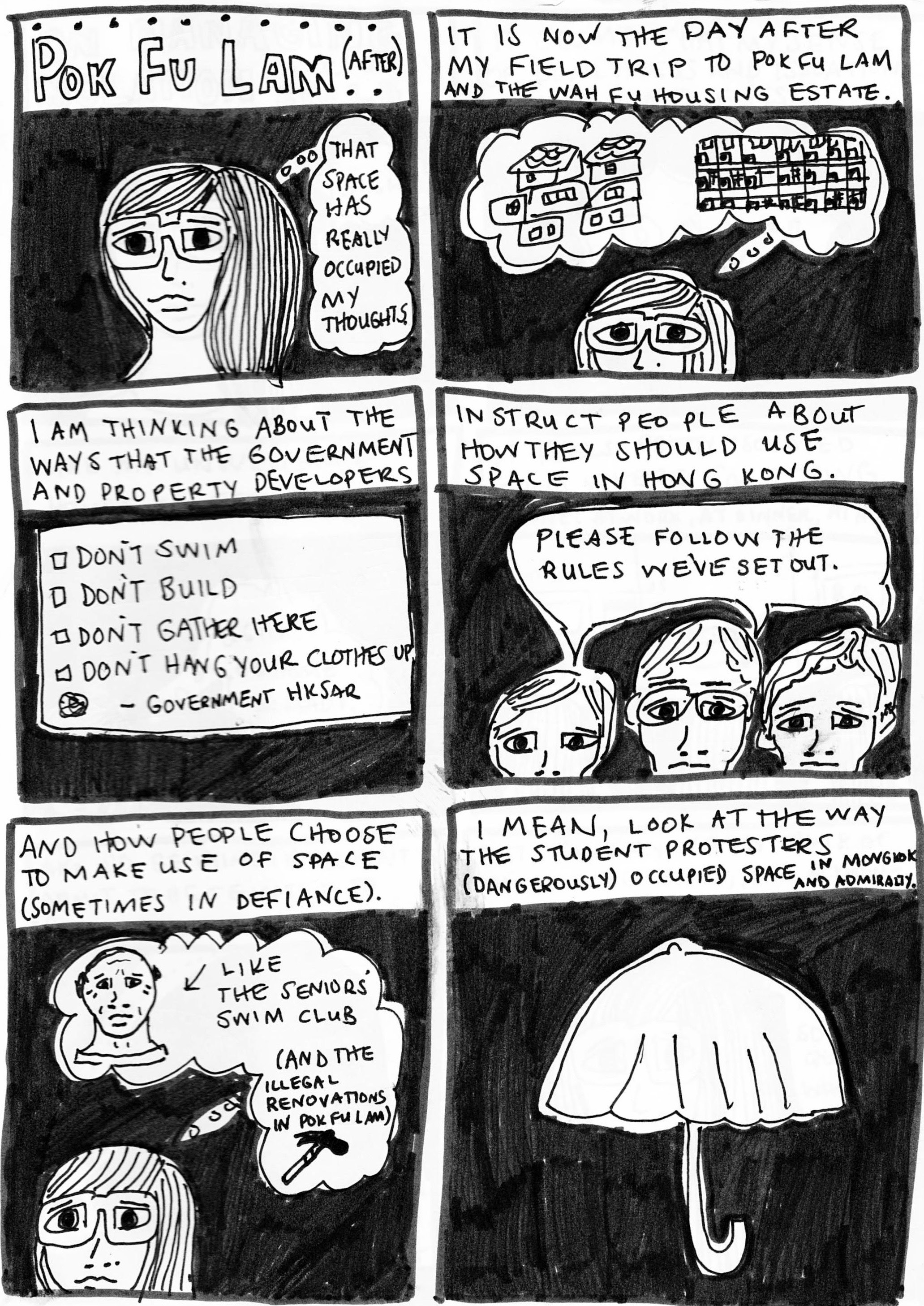NOTES FROM THE FIELD / NOTES DU TERRAIN
On keeping public visual fieldnotes as reflexive ethnographic practice
As I write this piece, I am working through the data collection for my doctoral project, “Looking back and looking around: Revisiting and exploring civic engagement through cellphilms with ethnic minority youth in Hong Kong” under the supervision of Claudia Mitchell at McGill University.1 In the project, I ask 11 ethnic minority young people, both male and female, aged 19-25, who have finished secondary school to think about and “speak back” (Mitchell & De Lange, 2013, p. 1) to the ways their histories were included and excluded during their school experiences. These participants are my former students, whom I taught from 2008 to 2010 in a government funded local school in Hong Kong. In the school’s discursive practices, these students were called “non-Chinese,” or more colloquially, “NC.” Throughout my project and in this article, I use the term ethnic minority to describe my participants as ethnically non-Chinese. I am also an ethnic minority, a non-Chinese person. However, as a Canadian-educated white woman, who moved to Hong Kong to teach and who moved back to Hong Kong to conduct research with my former students, my positionality as a privileged NC person must be made explicit here.
My dissertation research project examines both the political nature of school and of learning history (Seixas & Morton, 2013) in Hong Kong. Not enough is known about the way in which the experiences of Hong Kong’s ethnic minorities in its public schools affect their young adult lives, particularly in regard to their citizenship practices, sense of belonging, and sense of self. This doctoral project sets out to find out about the post-secondary school trajectories and memories of my former secondary school students, five years after our teacher-student relationship ended. I believe that there is a critical connection to be made between the ways that secondary school is experienced and remembered by my research participants and their developing adult identities. I am studying how memories of the representations of ethnic minority cultures and histories in secondary school curricula and schooling experiences may have shaped young people’s sense of civic engagement, self, and belonging in Hong Kong. As part of this work, I employ cellphilming (Dockney, Tomaselli & Hart, 2010) — videos made on a cellphone — as a participatory visual methodology. Here, the participants are creating critical media texts that speak to their own sense of self, belonging (ideas about where one is included and excluded), and civic engagement (comprehensive of the way one defines their political agency, and group membership) in Hong Kong.
The doctoral project builds from my master’s thesis Exploring the Education of Hong Kong’s Non-Chinese Speaking Secondary Students, which found that Hong Kong’s ethnic and linguistic minority, non-Chinese Speaking (NCS) secondary students’ lived experiences of school did not align with the Education Bureau’s policy to promote integration into its public schools (Burkholder, 2013). I look back to my previous findings in my Master’s work, and look to the present to understand the way that school has shaped the participants’ civic engagement in Hong Kong. My master’s work was limited in its ability to create and maintain dialogue amongst Hong Kong’s ethnic minority communities, and it has failed to reach policy makers. Engaging in this academic writing did not serve my participants in any concrete way, nor did it engage them in dialogue beyond the scope of our semi-structured ethnographic interviews. In short, the writing products — my thesis — from the project was not accessible to my participants, and I did not create sufficient opportunities for participant engagement with the findings.
With this history in mind, I have undertaken a different focus in my doctoral project. I do so in order to address the critique of my own previous qualitative and ethnographic work. For my doctoral work, I want to engage my participants in dialogue throughout all stages of my project, from brainstorming to creating critical media texts (cellphilms), disseminating the findings, and seeing my understandings and thought processes as they unfold. As I documented what I saw, as well as my relationship to the research participants and the political tensions in Hong Kong in the wake of the Umbrella Revolution,2 I looked to the practice of public visual fieldnote-taking to help construct my developing understandings of the research space, my participants’ thoughts, and Hong Kong’s distinct socio-political context. In her “Notes from the Field,” Jen Thompson (2014) argued that the practice of fieldnotes in participatory research is complicated. She also questioned how the practice of writing private fieldnotes might not align with the theory of participatory arts-based methodologies. I share this concern. Thompson (2014) wrote that
heeding critiques of participation as a form of social control, my work incorporates ongoing tensions about the nature of participation. Therefore, it dawned on me that writing fieldnotes risks being one of the least participatory things a researcher can do. (p. 252)
Burawoy (2003), however, suggested that fieldnotes are a necessary “dialogue between [the] observation and theory” (p. 669) that we do as researchers. I keep both Burawoy and Thompson in mind as I complete my fieldnotes.
One way that I endeavor to promote engagement in this participatory project is by keeping public visual fieldnotes in a blog: https://caseyandthefield.wordpress.com/. These fieldnotes have included pieces of informal writing, photographs from my life in Hong Kong, links to articles that I find interesting, and most often, hand-drawn comics that show my thinking as it unfolds. I have made this blog public in order to engage in a dialogue with those who choose to read it, as well as to ground the study in the reflexive revisit (Burawoy, 2003). When participants were recruited, I asked for their consent in all parts of the project: from semi-structured interviewing to cellphilm-making to engaging with the fieldnotes. Participants were explicitly given a link to the blog, and often commented on the blog in our conversations and in our online communications (e-mails and texts). If a participant had voiced any concern over the content of the fieldnotes, I would have removed it immediately. Throughout the fieldwork, I continued to reflect and engage with what I had seen, but I attempted to do so in a participatory forum — encouraging others to engage with my preliminary understandings as they unfolded.

Figure 1. On managing isolation in the field (Burkholder, 2015a)
My doctoral project and visual fieldnotes are rooted in focused revisiting as reflexive ethnography (Burawoy, 2003). In engaging in revisiting as theory and methodology, I turned to Burawoy’s work, which suggested that theory, reflexivity, and positionality should anchor ethnographic research that employs a revisiting approach. What does this mean? One type of revisiting looks to return to the field of study with the same population as a previous study, but at a new point in time. Here, the revisit does not encourage “replication” of a previous study, but rather, “to focus on the inescapable dilemmas of participating in the world we study, on the necessity of bringing theory into the field, all with a view to developing explanations of historical change” (p. 647). As my research unfolded in Hong Kong, I worked with the same participants as my master’s work (as well as my first teaching experiences), the site itself had not changed, but my relationship to the participants had shifted with time, as they grew into young adults, and I am no longer their teacher. Rather than understanding the field as a place in time that is static, the revisit anchors in reflexivity to articulate that the field itself is “always in flux” and can only be “grasped through theoretical lenses and through the ethnographer’s interactions with those he or she studies” (Burawoy, 2003, p. 669). In a later publication, Burawoy (2009) clarified that grounded theorists often focus too narrowly on the now, while revisiting firmly situates the study both in theory and in the history of the field (as it evolves). The revisit asks the researcher to look around, go back, look again, and continue to develop a reflexive understanding of their place in the field and to the participants as well as the research. Focused revisiting looks to reexamine the researcher’s previous understandings of the field, and thus fits well as an anchor for this participatory project. While public blogging as an ethnographic approach is not new (Burawoy, 2009; Saka, 2008), the practice of public ethnography is filled with questions, including: “How does ethnographic knowledge circulate and how does it reach the public sphere? How [might we] navigate publics and reach audiences outside the academe?” (Cunha & Lima, 2010, p. 65)
Guided by Cumha and Lima’s (2010) questions, I have used these fieldnotes to engage my participant and the public with the project as it progressed. Here too, the participants (and public) engaged with and commented on the fieldnotes in digital spaces and in our in-person conversations. While the research unfolded, the participants followed along, and spoke with me about the themes and critical moments that I thought, wrote, and drew about.
In my fieldnotes, I explored a number of themes, and my writing and drawing practices have remained relatively consistent as I lived and did fieldwork in Hong Kong from January to June 2015. As the day stretched on, I would write my fieldnotes based on what I had seen, what I read, or what I was thinking about. My inspiration was situated in my day-to-day realities. Some entries dealt with meeting my research participants. Some entries explored ideas that have emerged from readings that I have done. Other entries focused on the loneliness that I was experiencing in a new disciplinary setting (City University’s School of Creative Media), far away from my loved ones. Other entries sprung out of conversations I eavesdropped on as I ate meals alone. Many entries grappled with the notion of space in the city of Hong Kong as well as my thoughts on belonging. In my fieldnotes, I used the names chosen by my participants so that they were not identifiable. My drawings are not so true-to-life that participants could be identified. I used both their words (in quotations) as well as my recollections of our conversations (see Figure 2).

Figure 2. On coffee with Khan (Burkholder, 2015c)
This writing and drawing about my findings and our conversations were made public from the start in order to engage the participants in my thoughts as they unfolded, as well as to do member-checking — the process by which a researcher checks in with participants to ensure that they have understood participants’ ideas — throughout the fieldwork. Instead of creating a findings sheet after writing the thesis, this method of sharing my thoughts was meant to address my earlier critique that the work was not made accessible to the participants throughout my master’s thesis.
In the evening, generally after dinner, I would sit in a public space and add the drawings to my writing. The following morning, I would add the definition and shading to my drawings, photograph each panel, and upload it to my blog.

Figure 3. Pok Fu Lam (after) (Burkholder, 2015b)
While the research was ongoing, the practice of public blogging and disseminating public visual fieldnotes helped spur dialogue in order to address some of my concerns about my previous Master’s work. While I am endeavoring to create dialogue about social and educational change for ethnic minorities in Hong Kong, I must also think about the ways in which this project might create real and imagined change in these communities (not all of which is empowering). For example, Gubrium & Harper (2013) wrote about the gaps between the theories and practices of participatory research, and the challenges in negotiating competing “perspectives, priorities, assumptions, values, beliefs and languages of ‘participation’ and ‘research,’ as well as over it’s conceptualization of ‘community’” (p. 3) between researcher and participant. Throughout the project, my participants talked with me about what I drew in our in-person conversations. They were most engaged with the genre of the comic book-style entries, and were taken with my renderings of them. I engaged in a comic-book style because this is a form of personal journaling that I began practicing when I was teaching in Hong Kong. Since that time, I have used the genre of comics to decompress, and to analyze my day-to-day experiences. Sharing my thoughts and findings with my participants is much more accessible (and much less boring) in these comics than in a 150-page thesis. While I did not feel inhabited or constrained by the thought of representing my thinking to my audience in the project, I wonder what might have happened if moments of disjuncture had occurred. How might I have navigated the potential disjuncture in the public forum? This is a point to consider as the practice unfolds and time goes on. In this project with ethnic minority young adults, I hope to use the digital archive of these fieldnotes and an archive of the cellphone videos (cellphilms) we are creating collaboratively to encourage ongoing conversations about ethnic minority education in Hong Kong and social action to inspire educational change from grassroots organizing and activism. Of course, I cannot anticipate the ways in which the blog or the cellphilm archive might (or might not) be experienced by viewers in Hong Kong and abroad. I cannot anticipate how Hong Kong community members might react to these fieldnotes or participant-produced cellphilms if they see them. I cannot anticipate the comments that will come from these viewers, and the way that my research participants or I will understand them. However, I hope that in creating lasting products — the blog and cellphilm archive — that can shift with the participants’ and my understanding and that they control (in that they can delete their videos if and when they choose to, or comment on my fieldnotes), the knowledge produced by these participants can create further understanding about the way they see their worlds, selves, and the ways that they engage politically. I also hope to inspire other researchers who engage in participatory projects to think about engaging participants in their fieldnotes-taking practice. In producing these public visual fieldnotes, it is my intention to create opportunities for conversation within and beyond the scope of the research. The transparency in this public sharing situates the work in a participatory arts-based framework, and creates more opportunities for member-checking as the project continues over time..
My experience creating visual fieldnotes was positive and reactions were celebratory, but there are critical questions that remain. How might I be constrained in what I choose to disclose if moments of critical disjuncture occur? Will my fieldnotes be curated, and will I omit entries that I feel might be problematic or put my participants in a negative light? How might I adjust my practices as time passes? How will I continue to reflect upon reflexive ethnography as theory and method? How might my fieldnotes practice shift my understanding of participatory visual research in future projects? I will keep these questions at the fore as I return to the archive of these fieldnotes, and as I continue to work in the field.
NOTES
- 1. Thank you to the research participants, my former secondary students, who have grown into such wonderful and introspective adults. It is an honour to spend time with you, and learn about the ways you see the world. Thank you to Dr. Claudia Mitchell and Dr. Shannon Walsh who have helped me immensely through my fieldwork and my thinking. This project was made possible by the aid of a teaching assistantship from the City University of Hong Kong, and with grants from the Social Science Research Council of Canada (SSHRC) and the Jackie Kirk Fieldwork Fellowship (McGill University).
- 2. Occupy Central was a Hong Kong movement calling for democratic reform in the 2017 Chief Executive elections. Protestors used umbrellas to block police tear gas-usage, inspiring the name the Umbrella Revolution. From September to December 2014, young people in Hong Kong took to the streets and physically occupied specific portions of the city. Although the police cleared the streets in December 2014, the call for change persisted in the digital realm, and as recently as August 2016, physical manifestations of youth dissent and calls for independence continue to grab hold of the city. See http://www.scmp.com/topics/occupy-central and https://www.hongkongfp.com/?s=occupy+central for more details.
References
Burawoy, M. (2003). Revisits: An outline of a theory of reflexive ethnography. American Sociological Review, 68, 645-679.
Burawoy, M. (2009). Extended case method: Four countries, four decades, four great transformations, and one theoretical tradition. Berkley, CA: University of California Press.
Burkholder, C. (2013). “Just the school makes us non-Chinese”: Contrasting the discourses of Hong Kong’s Education Bureau with the lived experiences of its non-Chinese speaking secondary school population. Journal of Educational Research for Social Change, 2(2), 43-58.
Burkholder, C. (2015a, January 27). On managing isolation in the field. [Blog post]. Retrieved from https://caseyandthefield.wordpress.com/2015/01/27/on-managing-isolation-in-the-field/
Burkholder, C. (2015b, January 28). Pok Fu Lam (after). [Blog post]. Retrieved from https://caseyandthefield.wordpress.com/2015/01/28/pok-fu-lam-after/
Burkholder, C. (2015c, February 3). On coffee with Khan. [Blog post]. Retrieved from https://caseyandthefield.wordpress.com/2015/02/03/on-coffee-with-khan/
Cunha, M. I., & Lima, A. (2010). Ethnography and the public sphere: Summarizing questions. Etnografica, 14(1), 61-69.
Dockney, J., Tomaselli, K., & Hart, T. B. (2010). Cellphilms, mobile platforms and prodsumers: Hyper-individuality and film. The citizen in communication: Revisiting traditional, new and community media practices in South Africa. Cape Town, South Africa: Juta Press.
Gubrium, A., & Harper, K. (2013). Participatory visual and digital methods. Walnut Creek, CA: Left Coast Press.
Mitchell, C., & De Lange, N. (2013). What can a teacher do with a cellphone? Using participatory visual research to speak back in addressing HIV & AIDS. South African Journal of Education, 33(4), 1-13.
Seixas, P., & Morton, T. (2013). The big six historical thinking concepts. Scarborough, ON: Nelson Education.
Thompson, J. (2014). On writing notes in the field: Interrogating positionality, emotion, participation and ethics. McGill Journal of Education, 49(1), 247-254.